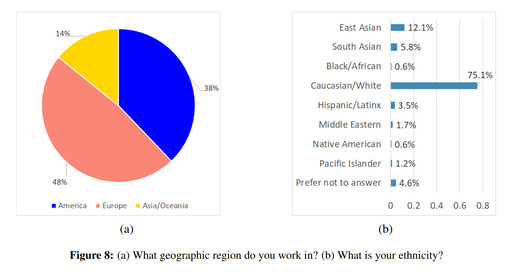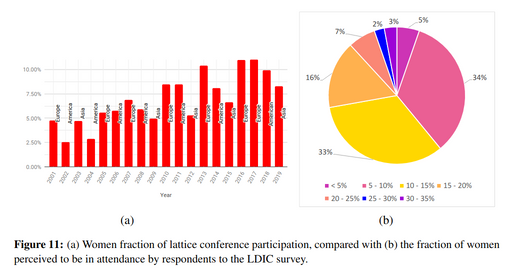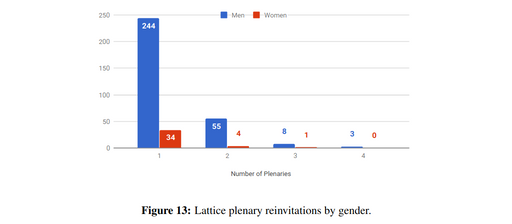Surveys
2019:
We report on the results of a survey done by the LDIC before the International Symposium of Lattice Field Theory 2019 to assess diversity and inclusivity in the Lattice community. The results were presented in the conference poster session and in the following proceedings [1]. We provide some exerpts directly from the proceedings to summarise the outcomes.
“There were 174 responses to the survey, many of which provided very thoughtful input. Half of the responses came from Europe, 1/3 from the US and the remaining 1/6 from Asia/Oceania/Africa. We find that the field is not particularly diverse and is (unsurprisingly) dominated by Caucasian/white heterosexual males. The proportion of male respondents was 83%, of female respondents was 11%, and 3% identified as gender fluid/non-binary. The percentage of female respondents is consistent with the average rate of participation at recent lattice conferences. The rate of transgender identification was 2%. The rate of respondents identifying as gay (4%) is within the range of expectations based on similar surveys [2, 3, 4, 5, 6].”
“There are issues with inclusivity in the community; 25–30% of respondents indicated not feeling comfortable infrequently or more often at talks, social events and even conference accommodations. A significant number of respondents (about 35%) has observed or had negative experiences. The nature of these experiences was not determined in the survey.”
A few summary plots from the proceedings are given here.
The following recommendations were made based on the results of the survey:
- Formalize the diversity committee and maintain the code of conduct. Survey diversity periodically, updating the questionnaire based on the lessons learned from this survey and keep statistical records.
- Continue the “Women in Lattice” lunches, opening this event to any interested participants.
- Regularly hold a plenary on the topic of diversity and inclusivity.
- Further increase the level of diversity in plenary talks and session chairs (not just monitoring the gender balance).
- Provide financial support for minorities as well as for students.
- Foster mentoring of junior colleagues. Identify senior physicists to meet with a group of younger scientists for career discussions.
- Attempt to promote international mixing between participants at different career stages.
- Establish a clear mechanism for reporting and responding to incidents of exclusion and harassment.
- Develop an informal practical guide for future local organizing committees, related to diversity and inclusivity, to help ensure a positive atmosphere for all participants. This should be updated and passed on from year to year, along with the lattice conference manual.
The proceedings concluded - “As discussed above, in general the community is amenable to programs such as this committee and other ways to improve diversity in the field. Steps should be taken in order to (as much as possible) improve inclusivity for all participants at all conferences. The IAC has approved our proposal to form a standing Diversity and Inclusivity Committee. This Committee will update the Code of Conduct, promote diversity and inclusivity in the community and periodically survey the progress made. We ask that any suggestions for improvement are forwarded to the members of this Committee.”
2021:
During the virtual International Lattice Symposium in 2021, a report on the Lattice Diversity and Inclusion Servey was presented by the LDIC as a poster [7].
References:
- C. Aubin, G. Bali, L. Del Debbio, W. Detmold, V. Gülpers, S. Hollitt, H.-W. Lin, L. Liu, S. M. Ryan, Report on the 2019 Lattice Diversity and Inclusivity Survey, PoS LATTICE2019 (2019) 295, [arXiv:1910.06800].
- T. J. Atherton, R. S. Barthelemy, W. Deconinck, M. L. Falk, S. Garmon, E. Long, M. Plisch, E. H. Simmons, and K. Reeves, LGBT Climate in Physics: Building an Inclusive Community, American Physical Society (2016).
- H.-W. Lin, Some Statistics on Women in Lattice QCD, PoS LATTICE2016 (2017) 366, [arXiv:1612.09367].
- B. Beckford, Strategies to improve diversity and inclusion in physics, Talk given at the XXXIX International Conference on High Energy Physics (ICHEP 2018) (2018).
- S. Yacoob, Diversity & Inclusion, Talk given at the XXXIX International Conference on High Energy Physics (ICHEP 2018) (2018).
- L. M. Aycock, Z. Hazari, E. Brewe, K. B. H. Clancy, T. Hodapp, and R. M. Goertzen, Sexual harassment reported by undergraduate female physicists, Phys. Rev. Phys. Educ. Res. 15 (Apr, 2019) 010121.
- C. Aubin, G. Bali, L. Del Debbio, W. Detmold, V. Guelpers, S. Hollitt, H.-W. Lin, L. Liu, S. Ryan, Report on the 2021 Lattice Diversity and Inclusion Survey, https://indico.cern.ch/event/1006302/contributions/4461232/attachments/2286341/3886003/LDIC_Poster_2021.pdf.





